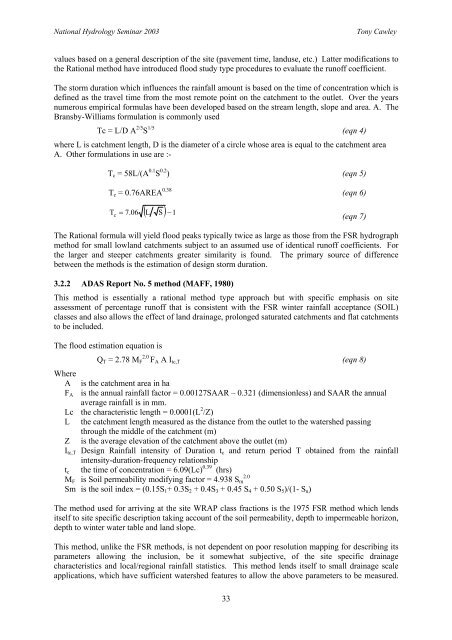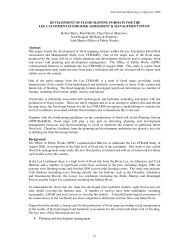COMMENT ON ESTIMATION OF GREENFIELD RUNOFF RATES ...
COMMENT ON ESTIMATION OF GREENFIELD RUNOFF RATES ...
COMMENT ON ESTIMATION OF GREENFIELD RUNOFF RATES ...
You also want an ePaper? Increase the reach of your titles
YUMPU automatically turns print PDFs into web optimized ePapers that Google loves.
National Hydrology Seminar 2003<br />
Tony Cawley<br />
values based on a general description of the site (pavement time, landuse, etc.) Latter modifications to<br />
the Rational method have introduced flood study type procedures to evaluate the runoff coefficient.<br />
The storm duration which influences the rainfall amount is based on the time of concentration which is<br />
defined as the travel time from the most remote point on the catchment to the outlet. Over the years<br />
numerous empirical formulas have been developed based on the stream length, slope and area. A. The<br />
Bransby-Williams formulation is commonly used<br />
Tc = L/D A 2/5 S 1/5 (eqn 4)<br />
where L is catchment length, D is the diameter of a circle whose area is equal to the catchment area<br />
A. Other formulations in use are :-<br />
T c = 58L/(A 0.1 S 0.2 ) (eqn 5)<br />
T c = 0.76AREA 0.38 (eqn 6)<br />
T c<br />
= 7.06<br />
( L S) −1<br />
(eqn 7)<br />
The Rational formula will yield flood peaks typically twice as large as those from the FSR hydrograph<br />
method for small lowland catchments subject to an assumed use of identical runoff coefficients. For<br />
the larger and steeper catchments greater similarity is found. The primary source of difference<br />
between the methods is the estimation of design storm duration.<br />
3.2.2 ADAS Report No. 5 method (MAFF, 1980)<br />
This method is essentially a rational method type approach but with specific emphasis on site<br />
assessment of percentage runoff that is consistent with the FSR winter rainfall acceptance (SOIL)<br />
classes and also allows the effect of land drainage, prolonged saturated catchments and flat catchments<br />
to be included.<br />
The flood estimation equation is<br />
Q T = 2.78 M F<br />
2.0<br />
F A A I tc,T (eqn 8)<br />
Where<br />
A is the catchment area in ha<br />
F A is the annual rainfall factor = 0.00127SAAR – 0.321 (dimensionless) and SAAR the annual<br />
average rainfall is in mm.<br />
Lc the characteristic length = 0.0001(L 2 /Z)<br />
L the catchment length measured as the distance from the outlet to the watershed passing<br />
through the middle of the catchment (m)<br />
Z is the average elevation of the catchment above the outlet (m)<br />
I tc,T Design Rainfall intensity of Duration t c and return period T obtained from the rainfall<br />
intensity-duration-frequency relationship<br />
t c the time of concentration = 6.09(Lc) 0.39 (hrs)<br />
2.0<br />
M F is Soil permeability modifying factor = 4.938 S m<br />
Sm is the soil index = (0.15S 1 + 0.3S 2 + 0.4S 3 + 0.45 S 4 + 0.50 S 5 )/(1- S u )<br />
The method used for arriving at the site WRAP class fractions is the 1975 FSR method which lends<br />
itself to site specific description taking account of the soil permeability, depth to impermeable horizon,<br />
depth to winter water table and land slope.<br />
This method, unlike the FSR methods, is not dependent on poor resolution mapping for describing its<br />
parameters allowing the inclusion, be it somewhat subjective, of the site specific drainage<br />
characteristics and local/regional rainfall statistics. This method lends itself to small drainage scale<br />
applications, which have sufficient watershed features to allow the above parameters to be measured.<br />
33

















